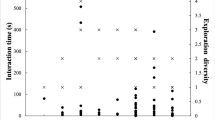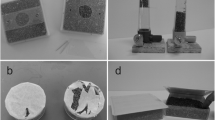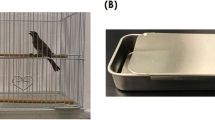Abstract
Urbanization represents a dramatic form of evolutionary novelty in the landscapes inhabited by many extant animals. The Cognitive Buffer Hypothesis suggests that innovation, the process by which animals solve novel problems or use novel behaviors, may be key for many animals when adapting to novel environments. If innovation is especially beneficial in urban environments, then we would expect urban animals to be more innovative than their non-urban counterparts. However, studies comparing innovative problem-solving between urban and rural habitats have produced mixed results. Here, we hypothesized that these findings result from comparing only two levels of urbanization when related research suggests that the stage of invasion of urban habitats likely has a strong effect on demand for innovation, with demand being highest during early establishment in a novel environment. To test this hypothesis, we assessed innovation in three locations where spotted hyenas experienced varying degrees of urbanization. Spotted hyenas are relatively innovative compared to other carnivores and, although many large carnivores in Africa are endangered, spotted hyenas remain abundant both inside and outside protected areas. We measured innovation with a multi-access puzzle box with four different doors through which hyenas could obtain a food reward. We predicted that hyenas in a transitional, rapidly urbanizing habitat would be more innovative, measured by the number of unique doors opened, than those in rural or fully urban habitats. Contrary to our predictions, hyenas in the rural habitat were the most innovative. These results challenge the idea that the evolutionary novelty associated with urbanization favors greater innovativeness.

Similar content being viewed by others
Data availability
The datasets generated during and/or analyzed during the current study are available in the Knowledge Network for Biocomplexity (KNB) repository, [https://doi.org/10.5063/9C6VTD].
References
Abay GY, Bauer H, Gebrihiwot K, Deckers J (2010) Peri-urban spotted hyena (Crocuta crocuta) in Northern Ethiopia: diet, economic impact, and abundance. Eur J Wildl Res 57:759–765. https://doi.org/10.1007/s10344-010-0484-8
Atwell JW, Cardoso GC, Whittaker DJ et al (2012) Boldness behavior and stress physiology in a novel urban environment suggest rapid correlated evolutionary adaptation. Behav Ecol 23:960–969. https://doi.org/10.1093/beheco/ars059
Audet J-N, Ducatez S, Lefebvre L (2016) The town bird and the country bird: problem solving and immunocompetence vary with urbanization. Behav Ecol 27:637–644. https://doi.org/10.1093/beheco/arv201
Auersperg AMI, von Bayern AMP, Gajdon GK et al (2011) Flexibility in problem solving and tool use of kea and New Caledonian crows in a multi access box paradigm. PLoS ONE 6:e20231. https://doi.org/10.1371/journal.pone.0020231
Baynes-Rock M (2015) Among the Bone Eaters: encounters with hyenas in Harar. Penn State Press
Belton LE, Cameron EZ, Dalerum F (2018) Social networks of spotted hyaenas in areas of contrasting human activity and infrastructure. Anim Behav 135:13–23. https://doi.org/10.1016/j.anbehav.2017.10.027
Benson-Amram S, Dantzer B, Stricker G et al (2016) Brain size predicts problem-solving ability in mammalian carnivores. Proc Natl Acad Sci 113:2532–2537. https://doi.org/10.1073/pnas.1505913113
Benson-Amram S, Holekamp KE (2012) Innovative problem solving by wild spotted hyenas. Proc R Soc B Biol Sci 279:4087–4095. https://doi.org/10.1098/rspb.2012.1450
Benson-Amram S, Weldele ML, Holekamp KE (2013) A comparison of innovative problem-solving abilities between wild and captive spotted hyaenas, Crocuta crocuta. Anim Behav 85:349–356. https://doi.org/10.1016/j.anbehav.2012.11.003
Biondi LM, Bó MS, Vassallo AI (2010) Inter-individual and age differences in exploration, neophobia and problem-solving ability in a Neotropical raptor (Milvago chimango). Anim Cogn 13:701–710. https://doi.org/10.1007/s10071-010-0319-8
Biondi LM, Fuentes GM, Córdoba RS, et al (2020) Variation in boldness and novelty response between rural and urban predatory birds: The Chimango Caracara, Milvago chimango as study case. Behav Processes 173: . doi: https://doi.org/10.1016/j.beproc.2020.104064
Boydston EE, Kapheim KM, Watts HE et al (2003) Altered behaviour in spotted hyenas associated with increased human activity. Anim Conserv 6:207–219. https://doi.org/10.1017/S1367943003003263
Brooks, Mollie E, Kristensen K, Benthem, Koen, J. V, et al (2017) glmmTMB Balances Speed and Flexibility Among Packages for Zero-inflated Generalized Linear Mixed Modeling. R J 9:378 . doi: https://doi.org/10.32614/RJ-2017-06
Brooks J, Kays R, Hare B (2020) Coyotes living near cities are bolder: implications for dog evolution and human-wildlife conflict. Behaviour 157:289–313. https://doi.org/10.1163/1568539X-bja10002
Caro TM (1994) Cheetahs of the Serengeti plains: group living in an asocial species. University of Chicago Press, Chicago
Chow PKY, Lea SEG, Leaver LA (2016) How practice makes perfect: the role of persistence, flexibility and learning in problem-solving efficiency. Anim Behav 112:273–283. https://doi.org/10.1016/j.anbehav.2015.11.014
Deaner RO, Barton RA, van Schaik CP (2003) Primate Brains and Life Histories: Renewing the Connection. In: Primate life histories and socioecology. University of Chicago Press, p 233
Diamond MC, Krech D, Rosenzweig MR (1964) The effects of an enriched environment on the histology of the rat cerebral cortex. J Comp Neurol 123:111–119
Diquelou MC, Griffin AS, Sol D (2015) The role of motor diversity in foraging innovations: a cross-species comparison in urban birds. Behav Ecol 27:584–591
Dougherty LR, Guillette LM (2018) Linking personality and cognition: a meta-analysis. Philos Trans R Soc B Biol Sci 373:
Dunbar RIM, Shultz S (2007) Evolution in the Social Brain. Science (80- ) 317:1344–1347 . doi: https://doi.org/10.1126/science.1145463
Fristoe TS, Iwaniuk AN, Botero CA (2017) Big brains stabilize populations and facilitate colonization of variable habitats in birds. Nat Ecol Evol 1:1706–1715. https://doi.org/10.1038/s41559-017-0316-2
Gade DW (2006) Hyenas and humans in the Horn of Africa. Geogr Rev 96:609–632
Glickman SE, Frank LG, Pavgi S, Licht P (1992) Hormonal correlates of’masculinization’in female spotted hyaenas (Crocuta crocuta). 1. Infancy to sexual maturity Reproduction 95:451–462
Green DS, Holekamp KE (2019) Pastoralist activities affect the movement patterns of a large African carnivore, the spotted hyena (Crocuta crocuta). J Mammal 100:1941–1953 . doi: https://doi.org/10.1093/jmammal/gyz135
Green DS, Johnson-Ulrich L, Couraud HE, Holekamp KE (2018) Anthropogenic disturbance induces opposing population trends in spotted hyenas and African lions. Biodivers Conserv 27:871–889. https://doi.org/10.1007/s10531-017-1469-7
Greenberg JR, Holekamp KE (2017) Human disturbance affects personality development in a wild carnivore. Anim Behav 132:303–312. https://doi.org/10.1016/j.anbehav.2017.08.023
Griffin AS, Guez D (2014) Innovation and problem solving: A review of common mechanisms. Behav Processes 109:121–134. https://doi.org/10.1016/j.beproc.2014.08.027
Griffin AS, Guillette LM, Healy SD (2015) Cognition and personality: an analysis of an emerging field. Trends Ecol Evol 30:207–214. https://doi.org/10.1016/j.tree.2015.01.012
Griffin AS, Netto K, Peneaux C (2017) Neophilia, innovation and learning in an urbanized world: a critical evaluation of mixed findings. Curr Opin Behav Sci 16:15–22. https://doi.org/10.1016/j.cobeha.2017.01.004
Hammond TT, Vo M, Burton CT, et al (2019) Physiological and behavioral responses reflect anthropogenic stressors in a resilient, human-tolerant mammal. J Mammal 1–13 . doi: https://doi.org/10.1093/jmammal/gyz134
Holekamp KE, Dantzer B, Stricker G et al (2015) Brains, brawn and sociality: a hyaena’s tale. Anim Behav 103:237–248. https://doi.org/10.1016/j.anbehav.2015.01.023
Holekamp KE, Dloniak SM (2010) Intraspecific Variation in the Behavioral Ecology of a Tropical Carnivore, the Spotted Hyena. In: Behavioral ecology of tropical animals, 1st edn. Elsevier, pp 189–229
Holekamp KE, Smale L, Berg R, Cooper SM (1997) Hunting rates and hunting success in the spotted hyena ( Crocuta crocuta ). J Zool 242:1–15. https://doi.org/10.1111/j.1469-7998.1997.tb02925.x
Huebner F, Fichtel C (2015) Innovation and behavioral flexibility in wild redfronted lemurs (Eulemur rufifrons). Anim Cogn 18:777–787. https://doi.org/10.1007/s10071-015-0844-6
Iglesias-Carrasco M, Aich U, Jennions MD, Head ML (2020) Stress in the city: meta-analysis indicates no overall evidence for stress in urban vertebrates. Proc R Soc B Biol Sci 287:20201754
Jarjour C, Evans JC, Routh M, Morand-Ferron J (2020) Does city life reduce neophobia? A study on wild black-capped chickadees. Behav Ecol 31:123–131. https://doi.org/10.1093/beheco/arz167
Johnson-Ulrich L, Holekamp KE (2020) Group size and social rank predict inhibitory control in spotted hyaenas. Anim Behav 160:157–168. https://doi.org/10.1016/j.anbehav.2019.11.020
Johnson-Ulrich L, Holekamp KE, Hambrick DZ (2020) Innovative problem-solving in wild hyenas is reliable across time and contexts. Sci Rep 10:13000. https://doi.org/10.1038/s41598-020-69953-5
Johnson-Ulrich L, Johnson-Ulrich Z, Holekamp K (2018) Proactive behavior, but not inhibitory control, predicts repeated innovation by spotted hyenas tested with a multi-access box. Anim Cogn 21:379–392. https://doi.org/10.1007/s10071-018-1174-2
Kang F, Goulet CT, Chapple DG (2017) The impact of urbanization on learning ability in an invasive lizard. Biol J Linn Soc 123:55–62
Kark S, Iwaniuk A, Schalimtzek A, Banker E (2007) Living in the city: can anyone become an “urban exploiter”? J Biogeogr 34:638–651. https://doi.org/10.1111/j.1365-2699.2006.01638.x
Kotrschal A, Taborsky B (2010) Environmental change enhances cognitive abilities in fish. PLoS Biol 8:e1000351. https://doi.org/10.1371/journal.pbio.1000351
Kummer H, Goodall J (1985) Conditions of Innovative Behaviour in Primates. Philos Trans R Soc B Biol Sci 308:203–214. https://doi.org/10.1098/rstb.1985.0020
Liebl AL, Martin LB (2014) Living on the edge: range edge birds consume novel foods sooner than established ones. Behav Ecol 25:1089–1096. https://doi.org/10.1093/beheco/aru089
Manrique HM, Völter CJ, Call J (2013) Repeated innovation in great apes. Anim Behav 85:195–202. https://doi.org/10.1016/j.anbehav.2012.10.026
McEwen BS, Sapolsky RM (1995) Stress and cognitive function. Curr Opin Neurobiol 5:205–216. https://doi.org/10.1016/0959-4388(95)80028-X
Møller AP (2009) Successful city dwellers: a comparative study of the ecological characteristics of urban birds in the Western Palearctic. Oecologia 159:849–858. https://doi.org/10.1007/s00442-008-1259-8
Morand-Ferron J, Cole EF, Quinn JL (2016) Studying the evolutionary ecology of cognition in the wild: a review of practical and conceptual challenges. Biol Rev 91:367–389. https://doi.org/10.1111/brv.12174
Pangle WM, Holekamp KE (2010) Lethal and nonlethal anthropogenic effects on spotted hyenas in the Masai Mara National Reserve. J Mammal 91:154–164. https://doi.org/10.1644/08-MAMM-A-359R.1
Papp S, Vincze E, Preiszner B et al (2014) A comparison of problem-solving success between urban and rural house sparrows. Behav Ecol Sociobiol 69:471–480. https://doi.org/10.1007/s00265-014-1859-8
Partecke J, Schwabl I, Gwinner E (2006) Stress and the city: urbanization and its effects on the stress physiology in European blackbirds. Ecology 87:1945–1952. https://doi.org/10.1890/0012-9658(2006)87[1945%3ASATCUA]2.0.CO%3B2
Prasher S, Evans JC, Thompson MJ, Morand-Ferron J (2019) Characterizing innovators: ecological and individual predictors of problem-solving performance. PLoS ONE 14:e0217464. https://doi.org/10.1371/journal.pone.0217464
Preiszner B, Papp S, Pipoly I et al (2017) Problem-solving performance and reproductive success of great tits in urban and forest habitats. Anim Cogn 20:53–63. https://doi.org/10.1007/s10071-016-1008-z
Pusey AE, Packer C (1994) Non-offspring nursing in social carnivores: minimizing the costs. Behav Ecol 5:362–374
R Core Team (2019) R: A language and environment for statistical computing
Reader SM, Laland KN (eds) (2003) Animal Innovation. Oxford University Press, New York
Reader SM, Morand-Ferron J, Flynn E (2016) Animal and human innovation: novel problems and novel solutions. Philos Trans R Soc B Biol Sci 371:20150182. https://doi.org/10.1098/rstb.2015.0182
Rojas-ferrer I, Morand-Ferron J, Rojas-ferrer I (2020) The impact of learning opportunities on the development of learning and decision-making: an experiment with passerine birds. Philos Trans R Soc B Biol Sci 375:20190496. https://doi.org/10.1098/rstb.2019.0496
Sayol F, Maspons J, Lapiedra O et al (2016) Environmental variation and the evolution of large brains in birds. Nat Commun 7:13971. https://doi.org/10.1038/ncomms13971
Schramme E (2015) Social Structure of Spotted Hyena (Crocuta crocuta) Populations around Mekelle city in Tigray. Universiteit Antwerpen, Ethiopia
Sih A (2013) Understanding variation in behavioural responses to human-induced rapid environmental change: a conceptual overview. Anim Behav 85:1077–1088. https://doi.org/10.1016/j.anbehav.2013.02.017
Sikes RS (2016) 2016 Guidelines of the American Society of Mammalogists for the use of wild mammals in research and education. J Mammal 97:663–688. https://doi.org/10.1093/jmammal/gyw078
Smith JE, Kolowski JM, Graham KE et al (2008) Social and ecological determinants of fission–fusion dynamics in the spotted hyaena. Anim Behav 76:619–636. https://doi.org/10.1016/j.anbehav.2008.05.001
Snell-Rood EC, Wick N (2013) Anthropogenic environments exert variable selection on cranial capacity in mammals. Proc R Soc B Biol Sci 280:20131384. https://doi.org/10.1098/rspb.2013.1384
Sol D (2009) Revisiting the cognitive buffer hypothesis for the evolution of large brains. Biol Lett 5:130–133. https://doi.org/10.1098/rsbl.2008.0621
Sol D, Duncan RP, Blackburn TM et al (2005) Big brains, enhanced cognition, and response of birds to novel environments. Proc Natl Acad Sci USA 102:5460–5465. https://doi.org/10.1073/pnas.0408145102
Sol D, Lapiedra O, González-Lagos C (2013) Behavioural adjustments for a life in the city. Anim Behav 85:1101–1112. https://doi.org/10.1016/j.anbehav.2013.01.023
Sol D, Sayol F, Ducatez S, Lefebvre L (2016) The life-history basis of behavioural innovations. Philos Trans R Soc Lond B Biol Sci 371:20150187- . doi: https://doi.org/10.1098/rstb.2015.0187
Sol D, Timmermans S, Lefebvre L (2002) Behavioural flexibility and invasion success in birds. Anim Behav 63:495–502. https://doi.org/10.1006/anbe.2001.1953
Steele TE (2013) VERTEBRATE RECORDS | Late Pleistocene of Africa. In: Elias SA, Mock CJ (eds) Encyclopedia of Quaternary Science, 2nd editio. Elsevier, pp 664–672
Swanson EM, Holekamp KE, Lundrigan BL et al (2012) Multiple determinants of whole and regional brain volume among terrestrial carnivorans. PLoS ONE 7:e38447. https://doi.org/10.1371/journal.pone.0038447
Thornton A, Samson J (2012) Innovative problem solving in wild meerkats. Anim Behav 83:1459–1468. https://doi.org/10.1016/j.anbehav.2012.03.018
Turner JW, LaFleur RM, Richardson AT, Holekamp KE (2020) Risk-taking in free-living spotted hyenas is associated with anthropogenic disturbance, predicts survivorship, and is consistent across experimental contexts. Ethology 126:97–110. https://doi.org/10.1111/eth.12964
van Horik JO, Langley EJG, Whiteside MA, Madden JR (2017) Differential participation in cognitive tests is driven by personality, sex, body condition and experience. Behav Processes 134:22–30. https://doi.org/10.1016/j.beproc.2016.07.001
Van Meter PE, French J a, Dloniak SM, et al (2009) Fecal glucocorticoids reflect socio-ecological and anthropogenic stressors in the lives of wild spotted hyenas. Horm Behav 55:329–37 . doi: https://doi.org/10.1016/j.yhbeh.2008.11.001
Wright TF, Eberhard JR, Hobson EA et al (2010) Behavioral flexibility and species invasions: the adaptive flexibility hypothesis. Ethol Ecol Evol 22:393–404. https://doi.org/10.1080/03949370.2010.505580
Yirga G, Ersino W, De Iongh HH et al (2013) Spotted hyena (Crocuta crocuta) coexisting at high density with people in Wukro district, northern Ethiopia. Mamm Biol—Zeitschrift für Säugetierkd 78:193–197. https://doi.org/10.1016/j.mambio.2012.09.001
(2017) Guidelines for the treatment of animals in behavioural research and teaching. Anim Behav 123:I–IX. https://doi.org/10.1016/S0003-3472(16)30351-7
Acknowledgements
We thank the Kenyan National Commission for Science, Technology and Innovation, the Kenya Wildlife Service, the Narok County Government, the Mara Conservancy, Brian Heath, James Sindiyo, the Naibosho Conservancy, and Mekelle University for permissions to conduct this research. This work was conducted under research permit no. NACOSTI/P/16/35513/10422, issued by the Kenyan National Commission on Science, Technology and Innovation. We also thank the many former graduate students and research assistants on the Mara Hyena Project who contributed to data collection and video coding. We thank Roy Bailiff at MSU Engineering for constructing the multi-access box.
Funding
This work was supported by the National Science Foundation (OISE1853934, IOS1755089) to KEH, by a National Science Foundation Graduate Research Fellowship (GRFP) to LJU, and by a Grant-in-Aid of Research (GIAR) award to LJU from the Society for Integrative and Comparative Biology (SICB).
Author information
Authors and Affiliations
Contributions
LJU and KEH conceived the project. LJU and KEH designed the methodology. LJU, GY, RLS, and KEH collected data. LJU and KEH analyzed the data and wrote the manuscript. GY and RLS edited the manuscript.
Corresponding author
Ethics declarations
Conflicts of interest
The authors report no conflicts of interest or competing interests relevant to the content of this article.
Ethics statement
This work was conducted under research permit no. NACOSTI/P/16/35513/10422, issued by the Kenyan National Commission on Science, Technology and Innovation. The data collection procedure followed here was also approved by the Michigan State University Institutional Animal Care and Use Committee (IACUC): AUF #04/16–050-00. All research procedures were designed to adhere to the American Society of Mammalogists (ASM) Guidelines for the use of wild mammals in research and education (Sikes 2016) and to the Association for the Study of Animal Behaviour (ASAB) Ethics Committee and the Animal Behaviour Society (ABS) Animal Care Committee Guidelines for the treatment of animals in behavioral research and teaching (2017). Subjects in all locations are habituated to the presence vehicles and vehicles served as mobile blinds to hide researchers from view during deployment and collection of the MAB. Hyena participation in trials with the MAB was entirely voluntary, but encouraged with the use of bait. Researchers took care to remain at least 5 m from hyenas when collecting the MAB, and the MAB was not collected until all hyenas had moved at least 5 m away. However, hyenas regularly approached stationary vehicles at much closer distances.
Additional information
Publisher's Note
Springer Nature remains neutral with regard to jurisdictional claims in published maps and institutional affiliations.
Supplementary Information
Below is the link to the electronic supplementary material.
Rights and permissions
About this article
Cite this article
Johnson-Ulrich, L., Yirga, G., Strong, R.L. et al. The effect of urbanization on innovation in spotted hyenas. Anim Cogn 24, 1027–1038 (2021). https://doi.org/10.1007/s10071-021-01494-4
Received:
Revised:
Accepted:
Published:
Issue Date:
DOI: https://doi.org/10.1007/s10071-021-01494-4




